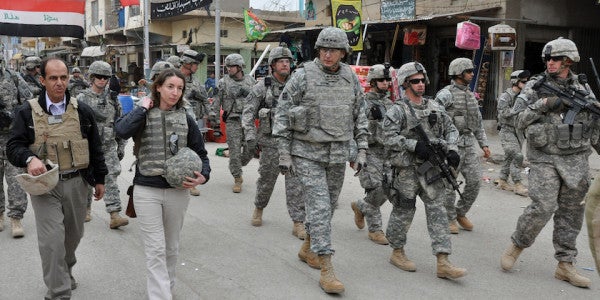The Army Tried To Bury A Critical Report On All Its Failings In The Iraq War
An unclassified 1,300-page “unvarnished history” of the Iraq War is at the center of a heated debate among Army leaders...

An unclassified 1,300-page “unvarnished history” of the Iraq War is at the center of a heated debate among Army leaders and historians over who gets credit for what, according to the Wall Street Journal.
The infighting has reportedly stalled the publication of the study, which was commissioned in 2013 by then-Army Chief of Staff Gen. Ray Odierno and remains unpublished. Sources told the Journal that Odierno urged a team of researchers consisting of some of the Army’s “brightest officers” to work expeditiously so that the history could publish while the lessons of the war “were most relevant.”
But it seems not everyone is convinced the general’s motives were pure.
- A chief concern of those who took issue with the first draft of the history — which was completed in 2016 — is how the authors chose to portray Odierno.
- According to the Journal, the study “hails President George W. Bush ‘surge’ of reinforcements and the switch to a counterinsurgency strategy overseen by Gen. David Petraeus and Gen. Odierno.”
- Odierno also apparently circumvented the standard process for “publishing the Army’s official conflicts,” after the Army’s Center of Military said the history would take five to 10 years.
- Time seemed to be of the essence. “Some of the officials foresaw trouble if the study wasn’t published before Gen. Odierno retired, which he did in August 2015,” the Journal writes.
- Furthermore, the study team was originally helmed by Army Col. Joel Rayburn, who served as an advisor to Petraeus in Iraq, according to the Journal.
- The tangled web of loyalties reportedly prompted one Army historian to draft a memo proposing major revisions to the study and raise the question of whether it was intended to “validate the surge” and thus, as the Journal puts it, “burnish Gen. Odierno’s and Gen. Petraeus’s legacy.”
- The 2007 surge coincided with a dramatic decline in the sectarian violence that had surged across Iraq the previous year, leading many to conclude that the extra troops and the counterinsurgency strategy Petraeus employed had succeeded in winning a seemingly un-winnable war. That narrative lost some of its luster in the ensuing years as the results proved temporary.
- But the history commissioned by Odierno has plenty of champions while Rayburn “defended the study’s portrayal of the ‘surge’ as a success,” according to the Journal.
- Meanwhile, retired Gen. Dan Allyn, who served as Army vice chief of staff when the history was completed in 2016, told the Journal that the brass sought to distance itself from the study in part because “senior leaders who were in position when these things happened, and they were concerned on how they were portrayed.”
- Among the many mistakes identified in the study, according to the Journal, are a chronic shortage of boots on the ground, heavily lopsided contributions by the various coalition partners, the consolidating of troops on large forward operating bases from 2004 to the troop surge, and the failure to prevent Iran and Syria from bolstering their favored militant groups in Iraq.
- Despite all the drama, however, the Army finally came around. Last week, the current Army chief of staff, Gen. Mark Milley, told the Journal that he had discarded plans to tweak the study and said it will be released in its original form — and with his stamp of approval — hopefully by Christmas.
